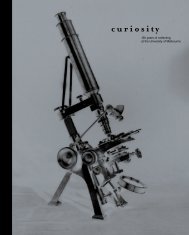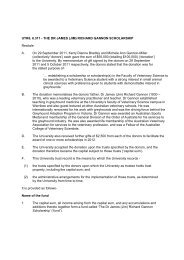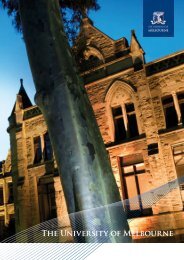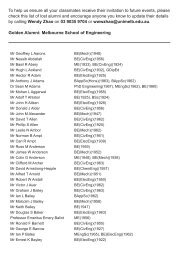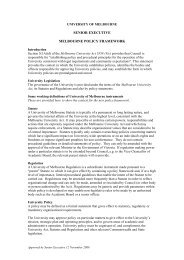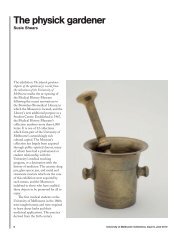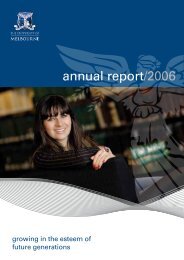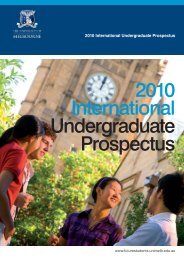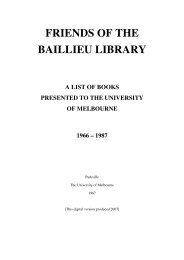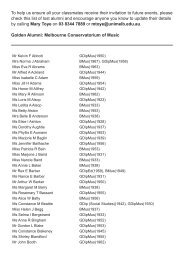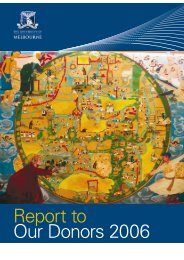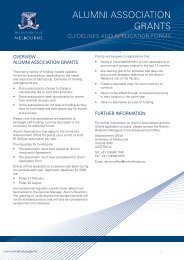Review of Australian Higher Education The Bradley Review
Review of Australian Higher Education The Bradley Review
Review of Australian Higher Education The Bradley Review
Create successful ePaper yourself
Turn your PDF publications into a flip-book with our unique Google optimized e-Paper software.
Despite this general over-supply, several dozen<br />
managerial and pr<strong>of</strong>essional occupations appear<br />
in government skills shortages lists (table A5).<br />
However, recruitment difficulties are <strong>of</strong>ten due to<br />
inadequate salaries or requirements for experience<br />
or specialisations universities cannot provide. Only<br />
where persistent tight labour markets exist for<br />
recent graduates is the shortage clearly due to few<br />
graduates. For health and engineering occupations,<br />
but not for others, we see a consistent pattern<br />
<strong>of</strong> 5% or fewer new graduates still looking for<br />
full-time work when surveyed a few months<br />
after completing their courses (table A6). All<br />
these occupations also appear in national skills<br />
shortage lists.<br />
A key question for this review is whether a<br />
different funding and regulatory system would<br />
avoid or alleviate these shortages more effectively<br />
than the current system. As can be seen in<br />
Figure 1, university <strong>of</strong>fers have now increased in<br />
all the courses related to areas <strong>of</strong> high labour force<br />
demand. In the same period, <strong>of</strong>fers for all other<br />
courses have been stable. With the exception <strong>of</strong><br />
dental studies (not shown), for which <strong>of</strong>fers grew<br />
rapidly from a low base, significant growth did not<br />
occur before 2005, which saw a 14% increase on<br />
2004 in <strong>of</strong>fers for places in health and engineering.<br />
Figure 1: Offers for places in areas <strong>of</strong><br />
skills shortage<br />
This slow response to health labour market<br />
pressures was not due to weak student demand.<br />
Figure 2 shows what percentage <strong>of</strong> eligible<br />
applicants were <strong>of</strong>fered a place in their preferred<br />
course. In the two years before 2005, a third <strong>of</strong><br />
applicants for nursing and other health courses<br />
(which includes pharmacy, physiotherapy, and<br />
other allied health pr<strong>of</strong>essions) received no <strong>of</strong>fer.<br />
Around 60% <strong>of</strong> applicants for dental courses and<br />
75% <strong>of</strong> applicants to medical courses were also<br />
rejected. Despite these <strong>Australian</strong> applicants<br />
missing out, throughout this period significant<br />
numbers <strong>of</strong> full-fee international students<br />
commenced health courses (table A7). In theory,<br />
universities could have reorganised existing<br />
domestic enrolments to meet local demand.<br />
<strong>The</strong> <strong>of</strong>fer rate for natural and physical sciences<br />
consistently exceeds 100%, meaning that some<br />
<strong>of</strong>fers go to applicants with first preferences<br />
in other courses. However, this redistribution<br />
<strong>of</strong> places did not happen. One reason is that<br />
faculty research budgets are in practice linked to<br />
enrolment numbers, and universities did not want<br />
to reduce science research. Instead, universities<br />
waited on new places from government, which<br />
arrived in significant numbers from 2005.<br />
Figure 2: Offer rates for selected disciplines<br />
180<br />
140%<br />
Index 2001=100<br />
160<br />
140<br />
120<br />
100<br />
80<br />
60<br />
40<br />
20<br />
0<br />
2001 2002 2003 2004 2005 2006 2007 2008<br />
Engineering<br />
Medical studies<br />
Nursing<br />
Other health<br />
All other courses<br />
Offer rate<br />
120%<br />
100%<br />
80%<br />
60%<br />
40%<br />
20%<br />
0%<br />
2001 2002 2003 2004 2005 2006 2007 2008<br />
Engineering<br />
Dental studies<br />
Medical studies<br />
Nursing<br />
Other health<br />
Natural and<br />
physical sciences<br />
180<br />
160<br />
140<br />
120<br />
100<br />
80<br />
60<br />
40<br />
20<br />
0<br />
2<br />
Source: DEEWR, Undergraduate Applications, Offers and<br />
Acceptances 2008<br />
Note: Dental studies removed to make movements in other<br />
disciplines more readable, but it shows rapid increase to an index<br />
<strong>of</strong> 363 by 2008.<br />
Source: DEEWR, Undergraduate Applications, Offers and<br />
Acceptances 2008<br />
University <strong>of</strong> Melbourne <strong>Bradley</strong> <strong>Review</strong> Submission



